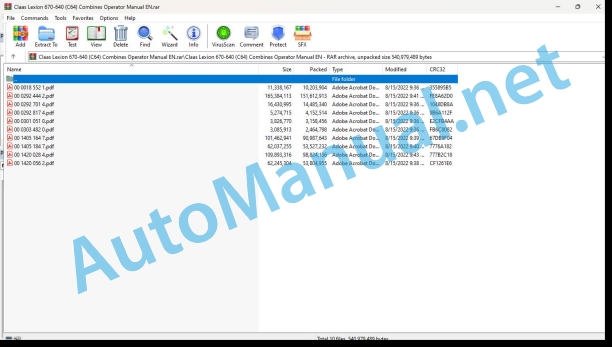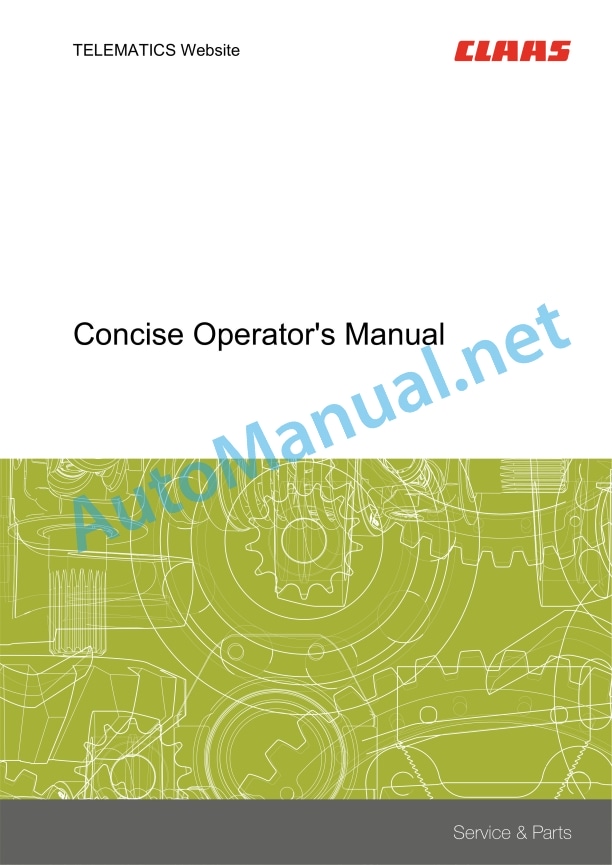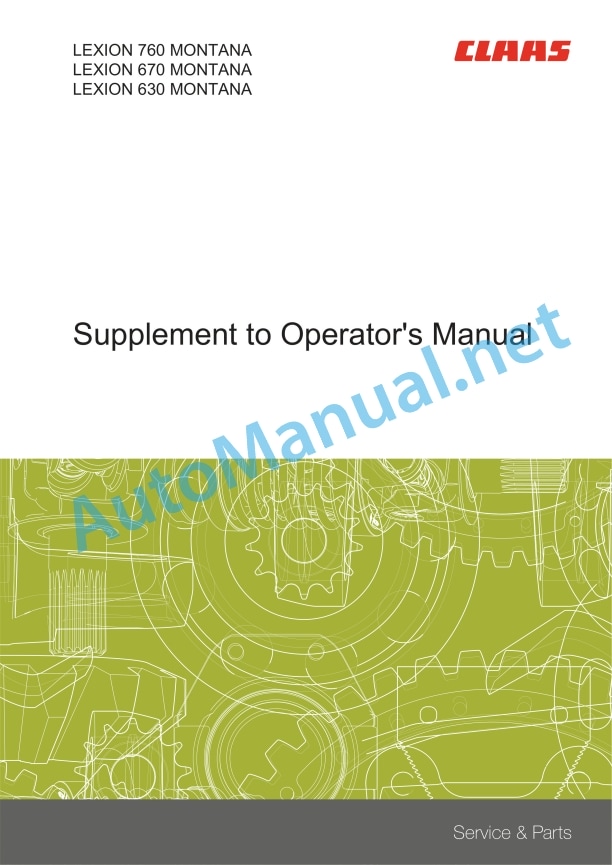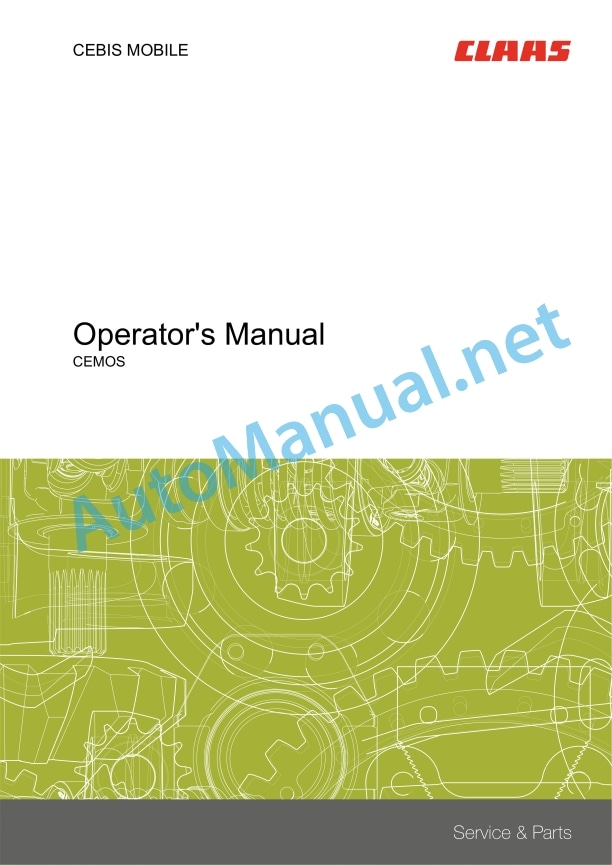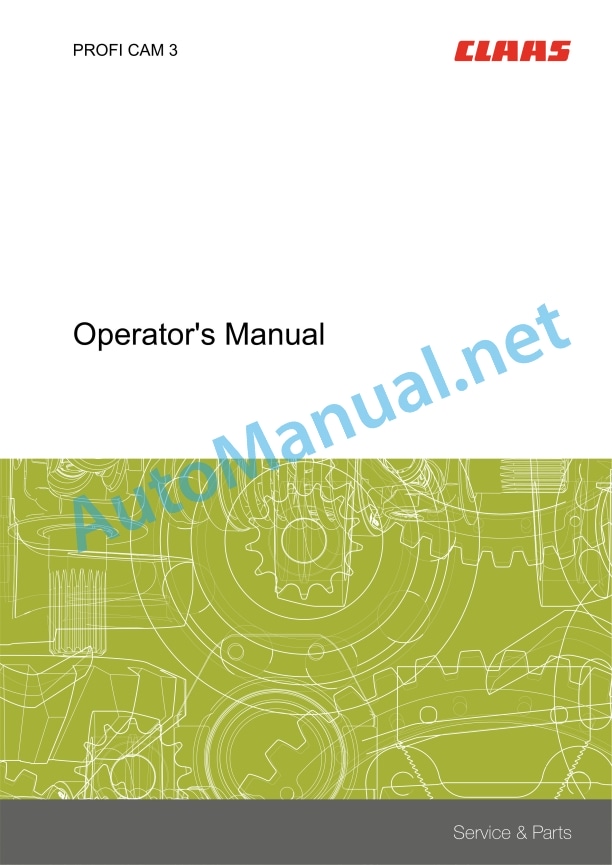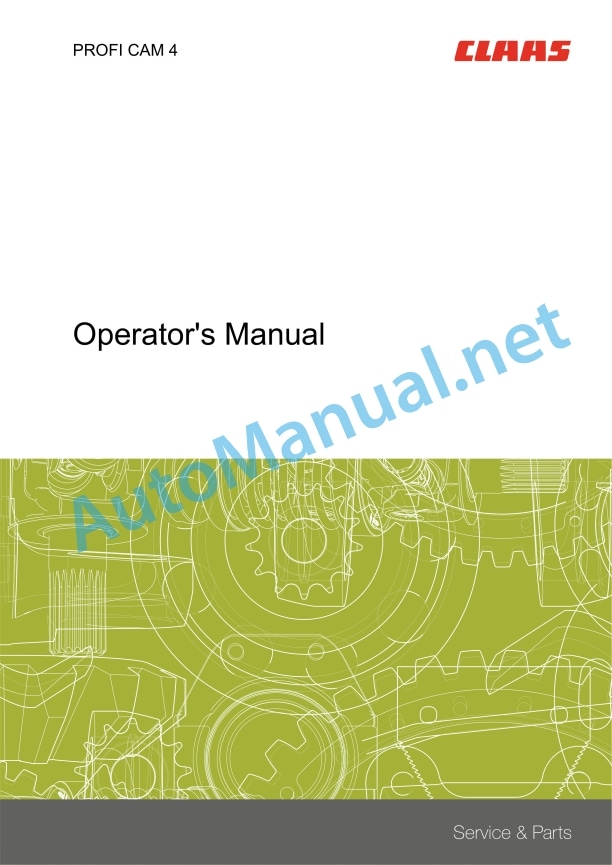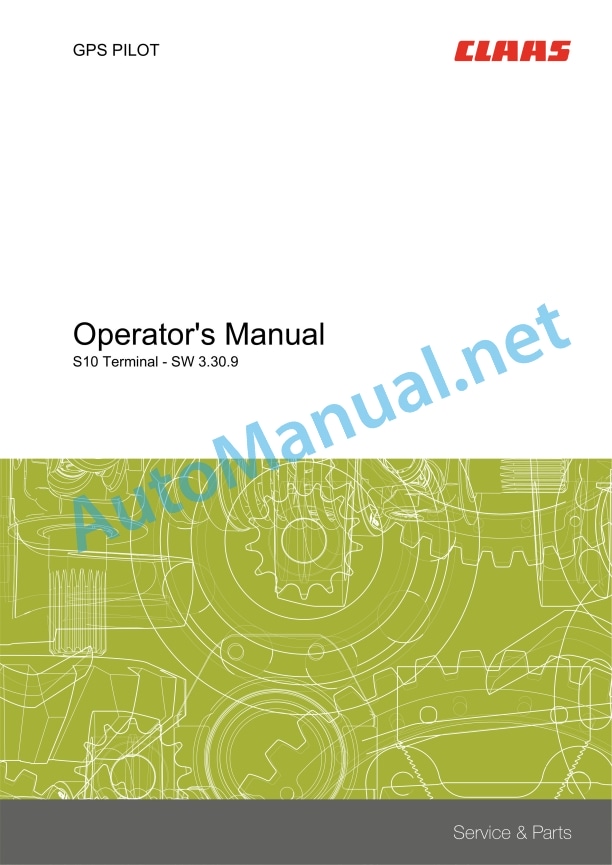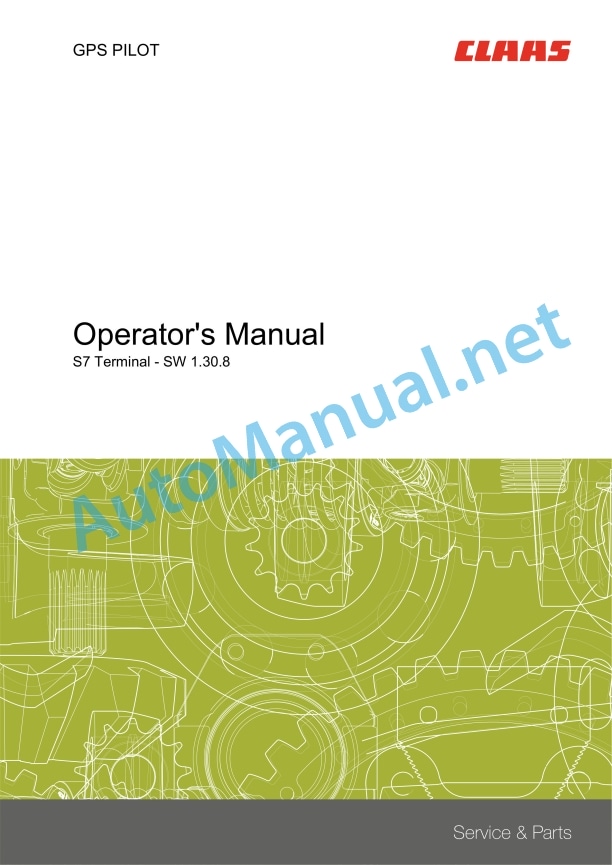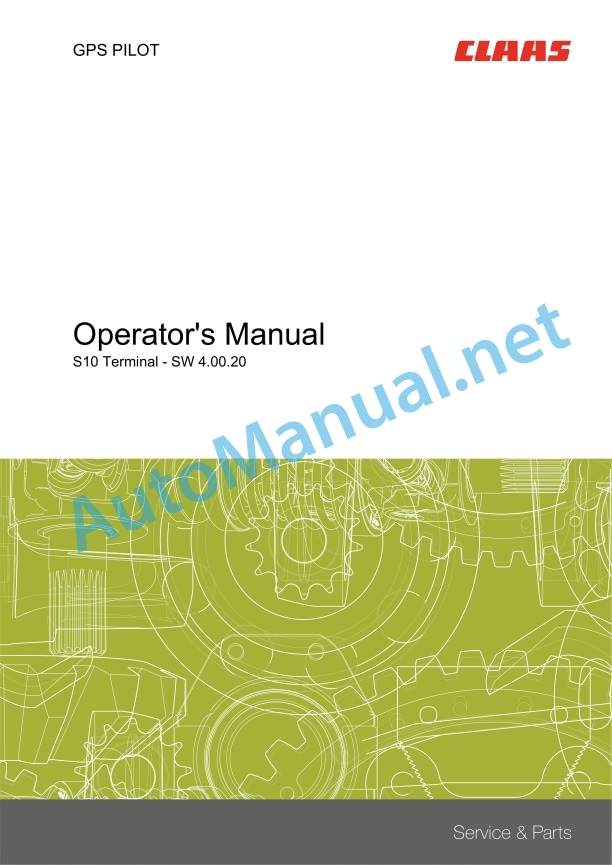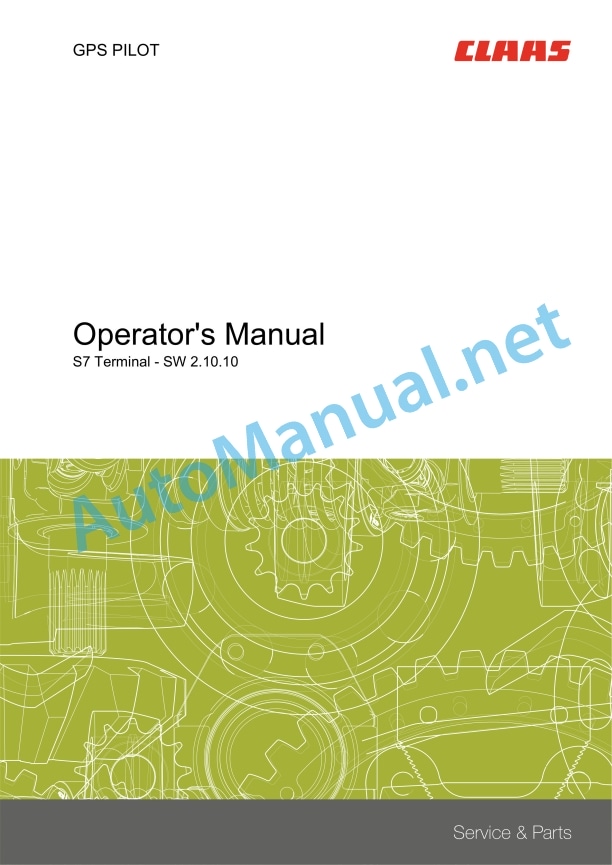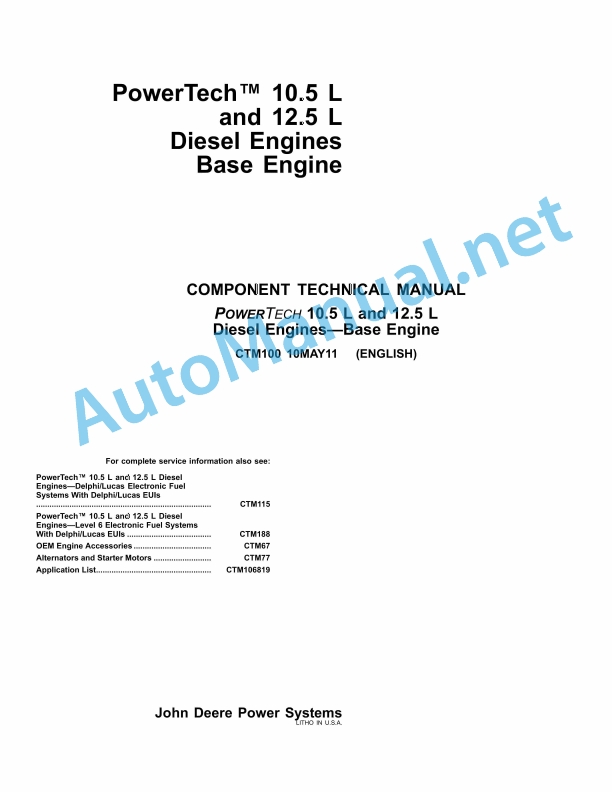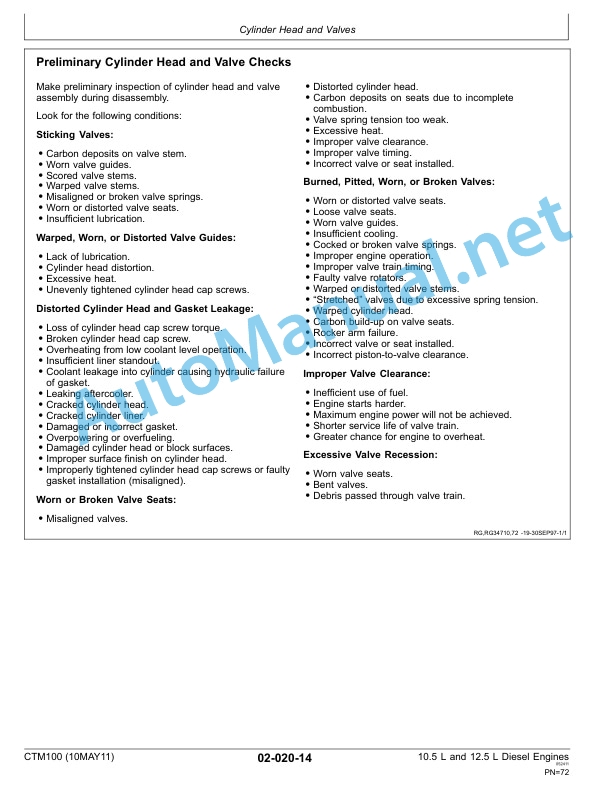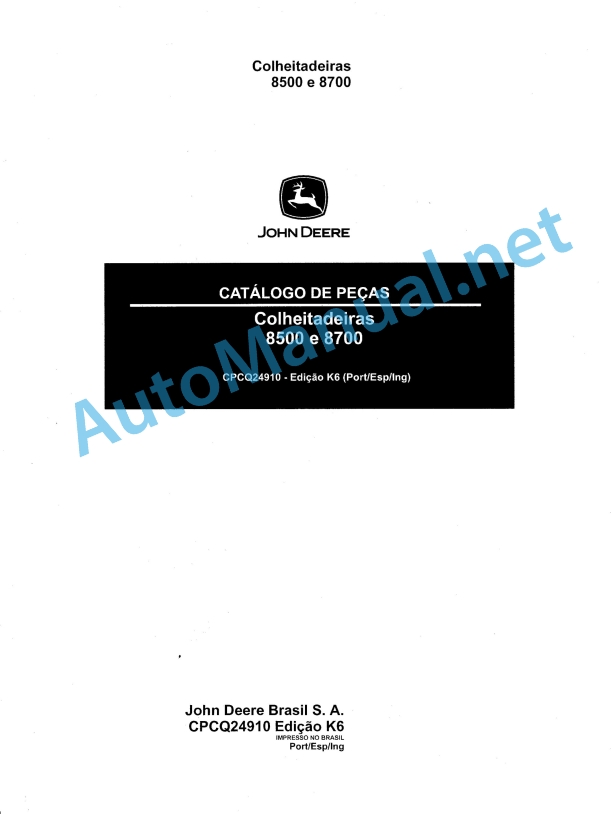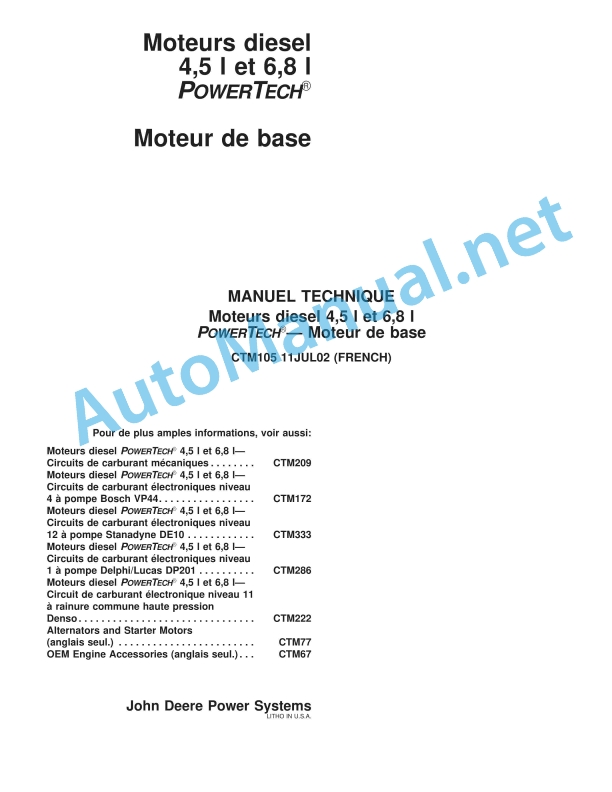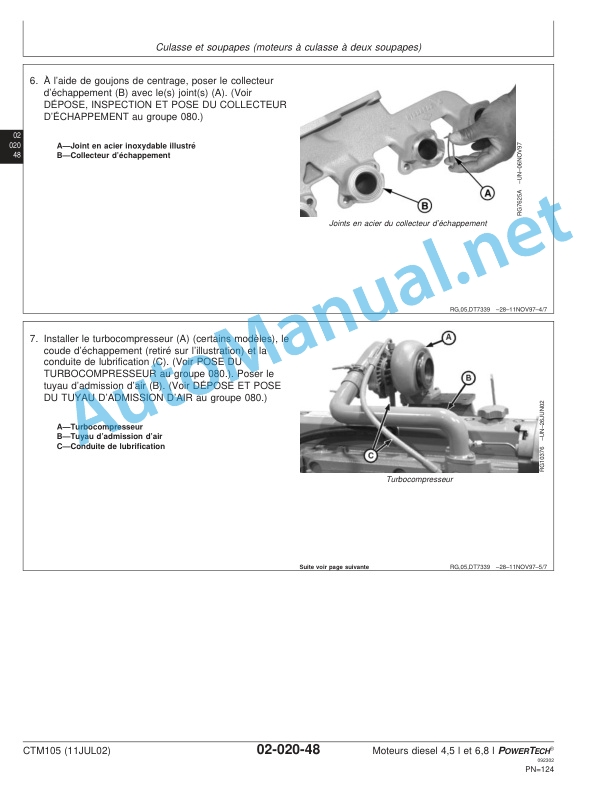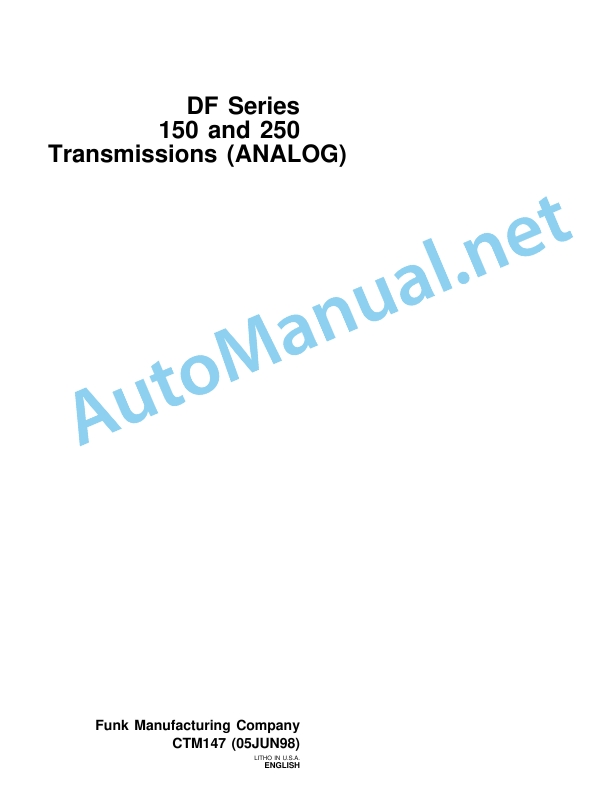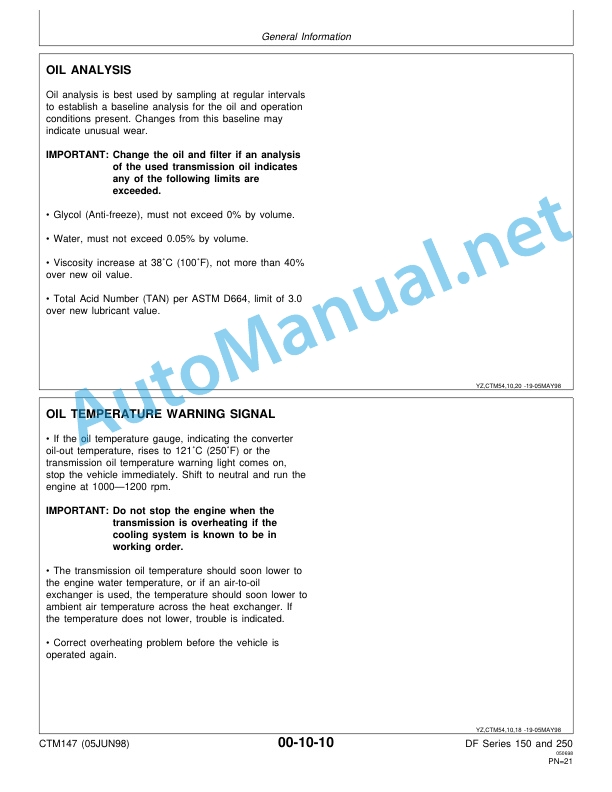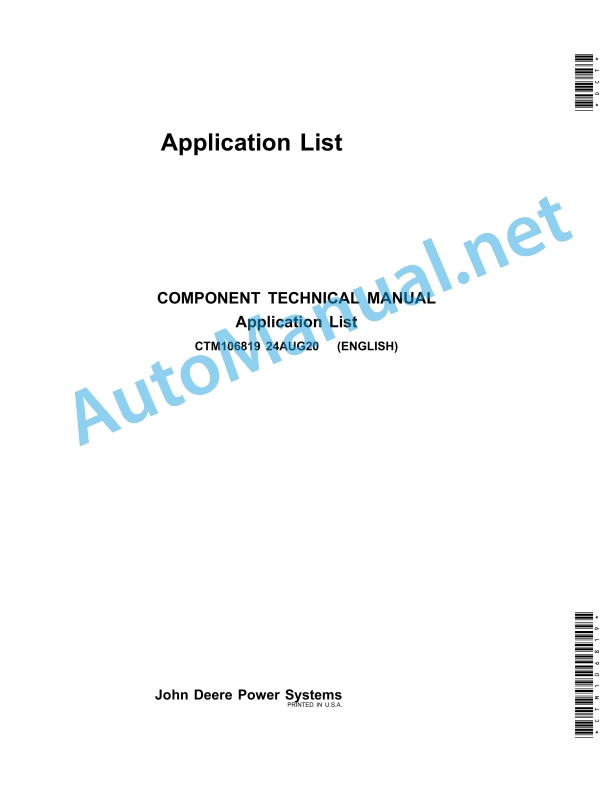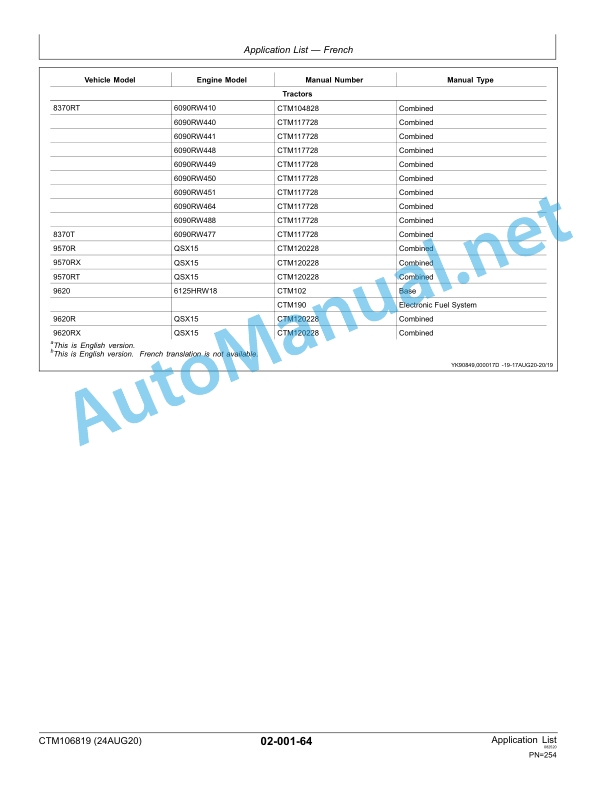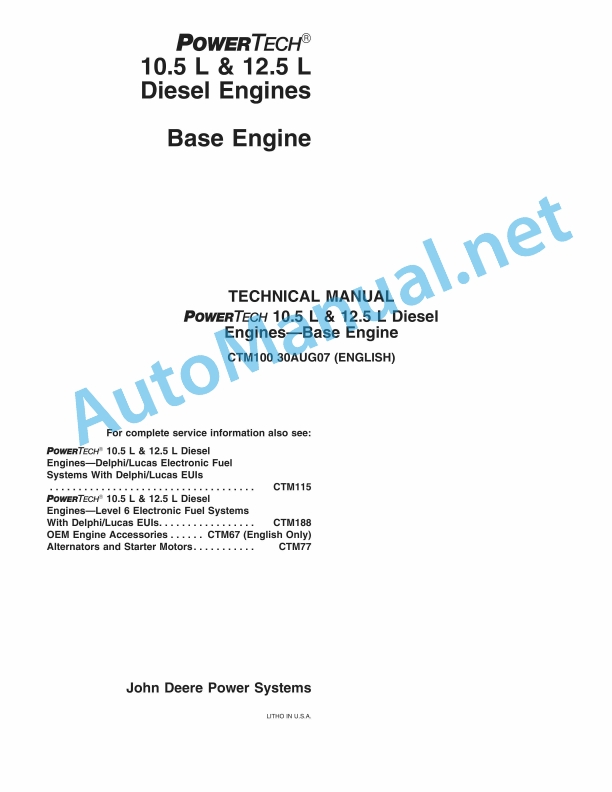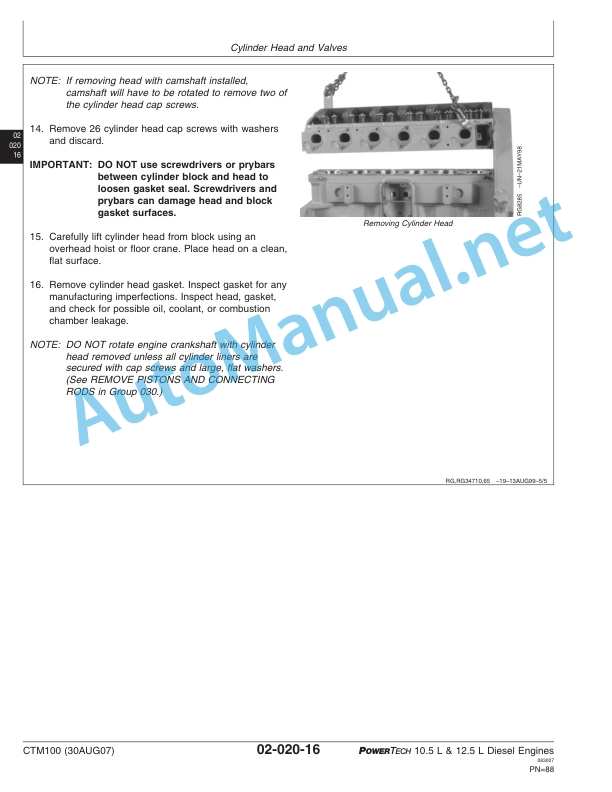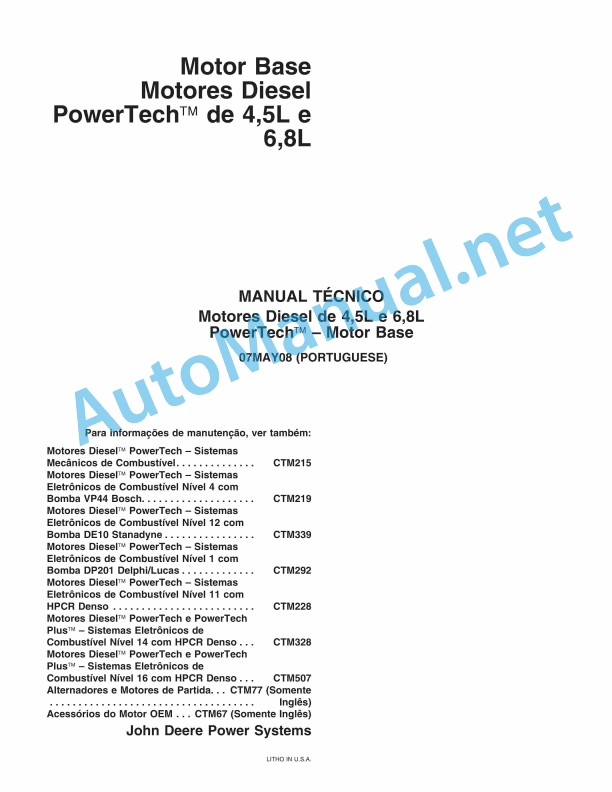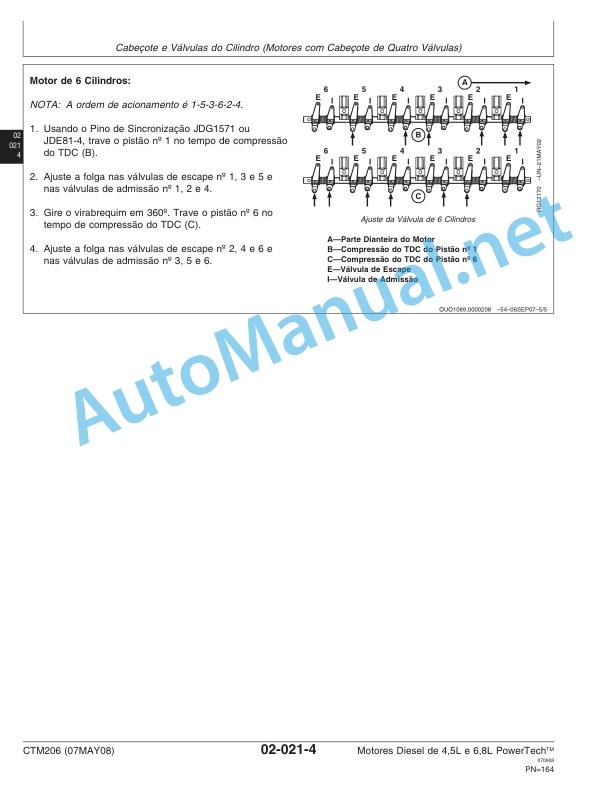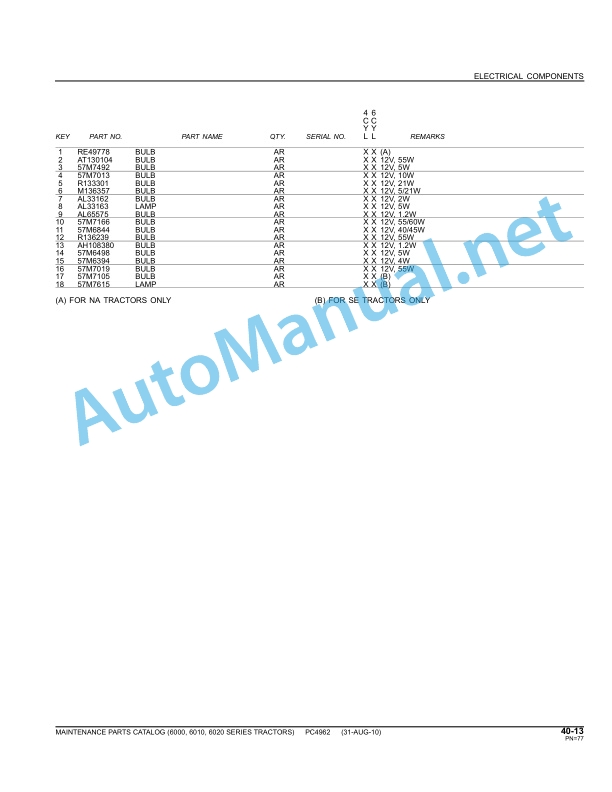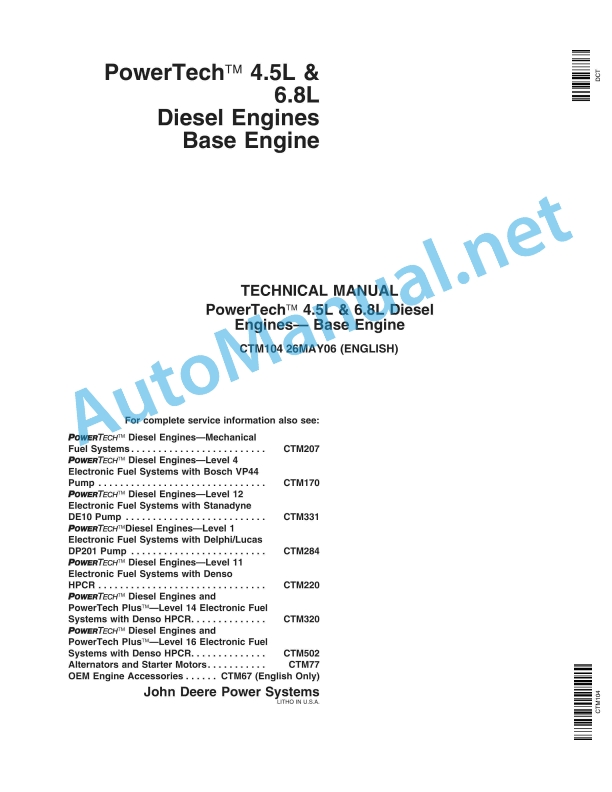Claas Lexion 670-640 (C64) Combines Operator Manual EN
$50.00
- Model: Lexion 670-640 (C64) Combines
- Type Of Manual: Operator Manual
- Language: EN
- Format: PDF(s)
- Size: 461 MB
File List:
00 0018 552 1.pdf
00 0292 444 2.pdf
00 0292 701 4.pdf
00 0292 817 4.pdf
00 0301 051 0.pdf
00 0303 482 0.pdf
00 1405 164 7.pdf
00 1405 184 7.pdf
00 1420 028 4.pdf
00 1420 056 2.pdf
00 0018 552 1.pdf:
TELEMATICS Website
Table of contents
1 About this Concise Operator’s Manual
1.1 Notes on the manual
1.1.1 Validity of manual
1.1.2 Notes regarding the Concise Operator’s Manual
1.1.3 Notes on warranty
2 Safety
2.1 Intended use
2.1.1 Proper use
3 Product description
3.1 Overview and method of operation
3.1.1 TELEMATICS product variants
3.1.2 TONI (TELEMATICS on implements)
3.1.3 Fleet View
3.1.4 TELEMATICS basic
3.1.5 TELEMATICS advanced
3.1.6 TELEMATICS professional
3.1.7 TELEMATICS app
4 Operating and control elements
4.1 TELEMATICS overview
4.1.1 Illustration conventions of buttons and navigation elements
4.1.2 Symbols and colours
4.2 Menu structure
4.2.1 Start screen
4.2.2 TELEMATICS website site map
4.2.3 Main menu overview
4.2.4
4.2.5
4.2.6
00 0292 701 4.pdf:
LEXION 760 MONTANALEXION 670 MONTANALEXION 630 MONTANA
Table of contents
1 To this Operator’s Manual
1.1 Notes on the manual
1.1.1 Validity of manual
1.1.2 Notes for the Operator’s Manual supplement
1.1.3 See the Operator’s Manual of the machine
1.1.4 Symbols and notes
1.1.5 Optional equipment
1.1.6 Qualified specialist workshop
1.1.7 Notes on maintenance
1.1.8 Warranty notes
1.1.9 Technical specifications
1.1.10 Spare parts and technical questions
2 Safety
2.1 Identifying warnings
2.1.1 Hazard signs
2.1.2 Signal word
2.2 Safety rules
2.2.1 Operation with slope compensation
2.3 Safety decals on the machine
2.3.1 Notes on safety decals
2.3.2 Safety decals on cab / on operator’s platform
3 Operating and display elements
3.1 Cab and operator’s platform
3.1.1 Operator’s platform
3.1.2 Operating panel
3.1.3 MONTANA control system control panel
4 Technical specifications
4.1 LEXION
4.1.1 Dimensions
Measurement conditions
4.1.2 Grain tank unloading tube dimensions
Measurement conditions
4.1.3 Turning circle diameter
Measuring conditions
4.1.4 Weights
Machine weight
Measurement conditions
Equipment variant weight
4.1.5 Sound pressure level and vibrations
4.1.6 CATERPILLAR C-13 diesel engine
4.1.7 Diesel engine CATERPILLAR C-9.3
4.1.8 Chassis
Ground speed
Measurement conditions
Properties
Tyre air pressure tables
4.1.9 Track width
Wheel track table 1
Wheel tread table 2
Wheel track table 3
Wheel track table 4
Wheel track table 5
Wheel track table 6
Wheel tread table 7
4.1.10 Brake
4.1.11 Steering
4.1.12 Electrical/electronic equipment
4.1.13 Crop feeding
4.1.14 Feeder unit
Measurement conditions
4.1.15 Threshing mechanism
Threshing mechanism properties
Preconcave
Main concave
Disawning
4.1.16 Separation
Separation system
Rotor separation system
Straw walker separating system
4.1.17 Cleaning unit
Cleaning system
Cleaning unit
4.1.18 Grain delivery
Grain tank capacity
Measuring conditions
Unloading capacity (maximum)
Grain delivery
4.2 Operating utilities
4.2.1 Lubricants
5 Machine preparation
5.1 Switching off and securing the machine
5.1.1 Shutting down and securing the machine
5.2 Prior to putting into operation
5.2.1 Prior to initial operation
5.3 Access to workplace and maintenance positions
5.3.1 Folding the ladder steps
5.3.2 Moving the access ladder
5.4 Front attachment
5.4.1 Installing universal drive shaft
5.4.2 Removing universal drive shaft
5.4.3 Mounting the multi-coupler
5.4.4 Dismounting the multi-coupler
5.5 Chassis
5.5.1 Jacking up the machine
5.5.2 Jacking up the machine for swinging the rear axle
5.5.3 Procedure for adjusting the rear axle track width
5.5.4 Adjusting the rear axle track width
5.5.5 Adjusting the rear axle track width
5.5.6 Adjusting the rear axle track width
5.5.7 Adjusting the rear axle track width
5.5.8 Select drilled holes on the adjustable element
5.6 Hydraulic system
5.6.1 Checking the front attachment load relief pressure accumulator
5.7 Assembly parts and machine body
5.7.1 Preassembling the access ladder
5.7.2 Installing the ladder
5.7.3 Fitting the additional weights for folding front attachments
5.8 Feed rake conveyor
5.8.1 Adjusting the feeder chain height
5.9 Threshing mechanism
5.9.1 Drum inspection cover
6 Operation
6.1 Gearbox, clutch and universal drive shaft
6.1.1 Engaging the differential lock
6.2 Chassis
6.2.1 Shifting gears
6.2.2 Engaging 4-TRAC*
6.2.3 Disengaging 4-TRAC*
6.2.4 MONTANA control system
6.2.5 Checking the MONTANA functions
6.2.6 Switching on the MONTANA control system
6.2.7 Lowering the machine fully before driving on the road
6.2.8 Moving the machine into the neutral position
6.2.9 Manual axle control
6.2.10 Manual front attachment control
6.2.11 Automatic mode
6.2.12 Changing the cutting angle/tilt (lateral levelling) in automatic mode
6.3 Brake
6.3.1 Applying the parking brake
6.3.2 Releasing the parking brake
7 Faults and remedies
7.1 Chassis
7.1.1 Chassis problems and remedies
7.2 Gearbox, clutch and universal drive shaft
7.2.1 Engaging the manual gearbox neutral position mechanically
7.3 Brake
7.3.1 Releasing the parking brake mechanically
7.3.2 Releasing the parking brake mechanically
7.4 Electric and electronic system
7.4.1 MONTANA control system problems and remedies
7.5 Feeder unit
7.5.1 Problems with and remedies for the feeder unit
8 Maintenance
8.1 Maintenance intervals
8.1.1 Before the harvest
8.1.2 Every 10 operating hours or daily
8.1.3 Every 50 operating hours
8.1.4 Every 100 operating hours
8.1.5 Every 500 operating hours or annually
8.2 Lubrication chart
8.2.1 Lubricating the grease points on the left every 100 operating hours
8.2.2 Lubricating the grease points on the right every 100 operating hours
8.2.3 Lubricating the grease points on the left every 500 operating hours
8.2.4 Lubricating the grease points on the right every 500 operating hours
8.3 Chassis
8.3.1 Check fastening of tyres
Drive axle
Steering axle
8.3.2 Checking the differential and axle carrier unit oil level
8.3.3 Changing the differential and axle carrier unit oil
Draining the oil
Topping up oil
8.3.4 Checking the oil level of drive axle wheel pivots
8.3.5 Changing the drive axle wheel pivot oil
Draining the oil
Topping up oil
8.3.6 Greasing the slewing rings of wheel pivots
8.3.7 Adjusting the wheel pivot linkages
8.3.8 Checking the oil level of the drive axle manual gearbox
8.3.9 Changing the drive axle manual gearbox oil
Draining the oil
Topping up oil
8.3.10 Checking the oil level of drive axle final drives
8.3.11 Changing the drive axle final drive oil
Draining the oil
Topping up oil
8.4 Brake
8.4.1 Checking the foot brake pressure warning
8.5 Feeder unit
8.5.1 MONTANA feeder housing – adjusting the feeder chains
8.5.2 Adjusting the basic setting of the cutting angle
8.5.3 Adjusting the basic setting of lateral position
00 0292 817 4.pdf:
CEBIS MOBILE
Table of contents
1 Introduction
1.1 Notes on the manual
1.1.1 Validity of manual
1.1.2 Information about this Operator’s Manual
1.1.3 Symbols and notices
1.1.4 Optional equipment
1.1.5 Notes on warranty
1.1.6 Spare parts and technical questions
2 Safety
2.1 Identifying warnings
2.1.1 Hazard signs
2.1.2 Signal word
2.2 Safety rules
2.2.1 Meaning of Operator’s Manual
2.2.2 Optional equipment and spare parts
3 Product description
3.1 Overview and method of operation
3.1.1 Overview of CEBIS MOBILE terminal
3.1.2 CEMOS function
3.2 Optional equipment
3.2.1 CRUISE PILOT*
3.2.2 CEMOS AUTO SEPARATION*
3.2.3 CEMOS AUTO CLEANING*
3.2.4 4D slope-dependent rotor cover plate control*
3.2.5 4D slope-dependent cleaning system control*
3.2.6 GRAIN QUALITY CAMERA*
3.3 Identification plates and identification number
3.3.1 Position of CEBIS MOBILE identification plate
4 Operating and control elements
4.1 CEBIS MOBILE onboard computer
4.1.1 Terminal
4.2 CEMOS
4.2.1 Main menu
4.2.2
4.2.3
4.2.4
4.2.5
4.2.6 Overview of harvest display
4.2.7 Status display symbols
5 Operation
5.1 Preparing fieldwork
5.1.1 Preparing optimisation
5.2 CEBIS MOBILE onboard computer
5.2.1 Switching on CEMOS
5.2.2 Starting CEMOS
5.2.3 Activating the application
5.2.4 Calling up the menu
5.3 CEMOS
5.3.1 Making system settings
5.3.2 Changing the harvesting conditions or machine equipment
5.3.3 Making the machine settings
5.3.4 Switching on machine observation
5.3.5 Starting optimisation
5.3.6 Evaluating optimisation
5.4 CEMOS AUTOMATIC
5.4.1 Setting the CEBIS display
5.4.2 Switching CEMOS AUTOMATIC* on
5.4.3 Setting the optimisation strategy*
5.4.4 Calibrating the longitudinal inclination sensor*
5.4.5 Activating CEMOS AUTOMATIC*
5.4.6 Switching CEMOS AUTOMATIC* off
00 0301 051 0.pdf:
PROFI CAM 3
Table of contents
1 Introduction
1.1 Notes on the manual
1.1.1 Validity of manual
1.1.2 Information about this Operator’s Manual
1.1.3 Symbols and notes
1.1.4 Optional equipment
1.1.5 Qualified specialist workshop
1.1.6 Maintenance information
1.1.7 Warranty notes
1.1.8 Spare parts and technical questions
1.2 Intended use
1.2.1 Intended use
1.2.2 Reasonably foreseeable misuse
2 Safety
2.1 Identifying warnings
2.1.1 Hazard signs
2.1.2 Signal word
2.2 Safety rules
2.2.1 Meaning of Operator’s Manual
2.2.2 Observing safety decals and warnings
2.2.3 Optional equipment and spare parts
3 Product description
3.1 Overview and method of operation
3.1.1 How the PROFI CAM works
3.2 Identification plates and identification number
3.2.1 Position of identification plates
3.2.2 Explanation of PROFI CAM identification plate
3.3 Information on the product
3.3.1 CE marking
4 Operating and control elements
4.1 Camera system
4.1.1 Camera system monitor
4.2 Menu structure
4.2.1 Main menu
4.2.2
4.2.3
4.2.4
4.2.5
4.2.6
5 Technical specifications
5.1 PROFI CAM
5.1.1 Monitor
5.1.2 Camera
5.1.3 Switch box
5.1.4 Degree of protection against foreign bodies and water
6 Preparing the product
6.1 Shutting down and securing the machine
6.1.1 Switching off and securing the machine
6.2 Prior to operation
6.2.1 Carry out prior to operation
6.2.2 Installing the sun protection
6.2.3 Aligning the camera
6.2.4 Connecting the camera electrics
7 Operation
7.1 Monitor
7.1.1 Switching on the monitor
7.1.2 Calling up the menu
7.1.3 Setting a menu item
7.1.4 Setting the image orientation
7.1.5 Setting automatic screen darkening
7.1.6 Image mirroring
7.1.7 Setting the trigger view
7.1.8 Setting the follow-up time for trigger view
7.1.9 Setting the display mode
7.1.10 Activating/deactivating a display mode
8 Faults and remedies
8.1 Electrical and electronic system
8.1.1 Overview of problems on PROFI CAM camera system
8.1.2 Replacing the switch box fuse
9 Maintenance
9.1 Maintenance intervals
9.1.1 Every 10 operating hours or daily
9.2 Camera system
9.2.1 Checking the camera system for dirt
9.2.2 Cleaning the camera
9.2.3 Cleaning the switch box
9.2.4 Cleaning the monitor
10 Placing out of operation and disposal
10.1 General Information
10.1.1 Putting out of operation and disposal
11 Technical terms and abbreviations
11.1 Abbreviations
11.1.1 Units
11.1.2 Abbreviations
11.1.3 Technical terms
00 0303 482 0.pdf:
PROFI CAM 4
Table of contents
1 Introduction
1.1 Notes on the manual
1.1.1 Validity of manual
1.1.2 Information about this Operator’s Manual
1.1.3 Symbols and notes
1.1.4 Optional equipment
1.1.5 Qualified specialist workshop
1.1.6 Maintenance information
1.1.7 Notes on warranty
1.1.8 Spare parts and technical questions
1.2 Intended use
1.2.1 Intended use
1.2.2 Reasonably foreseeable misuse
2 Safety
2.1 Identifying warnings
2.1.1 Hazard signs
2.1.2 Signal word
2.2 Safety rules
2.2.1 Meaning of Operator’s Manual
2.2.2 Structural changes
2.2.3 Optional equipment and spare parts
2.2.4 Operation only following proper putting into operation
2.2.5 Technical status
2.2.6 Respecting technical limit values
Respecting technical limit values
2.2.7 Hazards when driving on roads and fields
3 Product description
3.1 Overview and method of operation
3.1.1 How the PROFI CAM works
3.2 Identification plates and identification number
3.2.1 Identification plates
3.3 Information on the product
3.3.1 CE marking
4 Operating and display elements
4.1 Camera system
4.1.1 Camera system monitor
4.1.2 CEBIS
4.2 Menu structure
4.2.1 Main menu
4.2.2
4.2.3
4.2.4
4.2.5
4.2.6
5 Technical specifications
5.1 PROFI CAM
5.1.1 Monitor
5.1.2 Camera
5.1.3 Switch box
6 Preparing the product
6.1 Switching off and securing the machine
6.1.1 Switching off and securing the machine
6.2 Prior to putting into operation
6.2.1 Carry out prior to operation
6.2.2 Installing the sun protection
6.2.3 Aligning the camera
7 Operation
7.1 Monitor
7.1.1 Switching on the monitor
7.1.2 Calling up the menu
7.1.3 Setting a menu item
7.1.4 Setting the image orientation
7.1.5 Setting automatic screen darkening
7.1.6 Image mirroring
7.1.7 Setting the trigger view
7.1.8 Setting the follow-up time for trigger view
7.1.9 Setting the display mode
7.1.10 Activating/deactivating a display mode
8 Faults and remedies
8.1 Electric and electronic system
8.1.1 Overview of problems on PROFI CAM camera system
9 Maintenance
9.1 Maintenance intervals
9.1.1 Every 10 operating hours or daily
9.2 Camera system
9.2.1 Checking the camera system for dirt
9.2.2 Cleaning the camera
9.2.3 Cleaning the switch box
9.2.4 Cleaning the monitor
10 Putting out of operation and disposal
10.1 General information
10.1.1 Putting out of operation and disposal
11 Technical terms and abbreviations
11.1 Abbreviations
11.1.1 Units
11.1.2 Abbreviations
11.1.3 Technical terms
00 1405 164 7.pdf:
GPS PILOT
Table of contents
1 Introduction
1.1 General information
1.1.1 Validity of Manual
1.1.2 Information about this Operator’s Manual
1.1.3 Symbols and notes
1.1.4 Optional equipment
1.1.5 Qualified specialist workshop
1.1.6 Maintenance notes
1.1.7 Notes on warranty
1.1.8 Spare parts and technical questions
1.1.9 Licensing for road traffic
Sample report
Clearance certificate
General operating permit
1.2 Intended use
1.2.1 Intended use
1.2.2 Reasonably foreseeable misuse
2 Safety
2.1 Identifying warnings
2.1.1 Hazard signs
2.1.2 Signal word
2.2 Safety rules
2.2.1 Meaning of Operator’s Manual
2.2.2 Update of terminal software
2.2.3 Requirements made on all persons working with the product
2.2.4 Hazard areas
Hazard areas
2.2.5 Interaction between the control terminal and the machine or tractor
2.2.6 Structural changes
2.2.7 Optional equipment and spare parts
2.2.8 Use of USB devices
2.2.9 Operation only following proper putting into operation
2.2.10 Technical status
2.2.11 Hazard from damage on the product
2.2.12 Respecting technical limit values
Respecting technical limit values
2.2.13 Preparing the product for road travel
2.2.14 Hazards when driving on the road with an ISOBUS implement
Switching on the terminal during road travel.
2.2.15 Hazards when driving on the road and on the field
2.2.16 Electrocution by electrical system
2.2.17 Potentially fatal electric shock from overhead lines
2.2.18 Liquids under pressure
2.2.19 Maintenance operations and repair work
2.2.20 Driving with the GPS PILOT
Road travel
Fieldwork
2.2.21 Working with Task Control* and Section Control*
3 Product description
3.1 Overview and method of operation
3.1.1 Overview of GPS PILOT – Hydraulic system
3.1.2 Overview of GPS PILOT – Steer ready
3.1.3 Overview of GPS PILOT FLEX
3.1.4 Overview of GPS PILOT ex works
3.1.5 Overview of the S10 terminal
3.1.6 Overview of navigation computer (ECU)
3.1.7 Electric steering wheel
3.1.8 Overview of correction signals
EGNOS/WAAS/MSAS
Omnistar HP / XP / G2
RTK FIELD BASE and BASELINE HD
RTK FARM BASE
3.1.9 Module overview
BASELINE HD
RTK FIELD BASE
RTK (Motorola)
RTK FARM BASE
3.2 Safety devices
3.2.1 Automatic cut-out when the maximum speed is exceeded
3.2.2 Automatic cut-out when the speed falls below the minimum
3.2.3 Seat contact switch
3.2.4 Manual override
Electric steering wheel
3.3 Optional equipment
3.3.1 GPS L2*
3.3.2 GLONASS*
3.3.3 TURN IN*
3.3.4 AUTO TURN*
3.3.5 Task Control*
Task Control Basic*
Task Control Geo*
3.3.6 Section Control*
3.4 Identification plates and identification numbers
3.4.1 GPS PILOT identification plate
3.4.2 Identification plate of terminal
3.4.3 Identification plate of navigation controller
4 Operating and display elements
4.1 GPS PILOT
4.1.1 Master switch and drive switch
4.2 Overview of the S10 terminal
4.2.1 Layout conventions of buttons and displays
4.3 GPS PILOT menu structure
4.3.1 Start menu
Start menu without Task Control*
Start menu with Task Control*
4.3.2 Menu overview
4.3.3 Overview of display field
4.3.4
4.3.5
4.3.6
John Deere Parts Catalog PDF
John Deere Tractors 7500 Parts Catalog CPCQ26568 30 Jan 02 Portuguese
John Deere Repair Technical Manual PDF
John Deere PowerTech M 10.5 L and 12.5 L Diesel Engines COMPONENT TECHNICAL MANUAL CTM100 10MAY11
John Deere Parts Catalog PDF
John Deere Harvesters 8500 and 8700 Parts Catalog CPCQ24910 Spanish
John Deere Repair Technical Manual PDF
John Deere Repair Technical Manual PDF
John Deere DF Series 150 and 250 Transmissions (ANALOG) Component Technical Manual CTM147 05JUN98
John Deere Repair Technical Manual PDF
John Deere Application List Component Technical Manual CTM106819 24AUG20
John Deere Repair Technical Manual PDF
John Deere Repair Technical Manual PDF
John Deere Diesel Engines PowerTech 4.5L and 6.8L – Motor Base Technical Manual 07MAY08 Portuguese
John Deere Repair Technical Manual PDF

